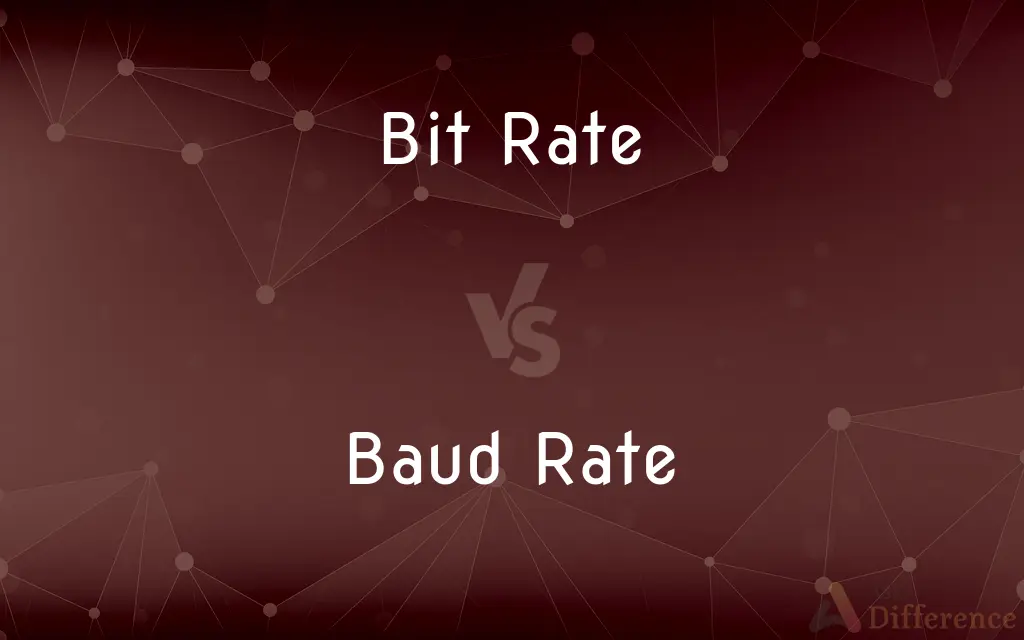Bit Rate vs. Baud Rate — What's the Difference?
By Tayyaba Rehman — Published on January 15, 2024
Bit rate measures the number of bits transmitted per second, while baud rate measures the number of signal changes or symbols per second.

Difference Between Bit Rate and Baud Rate
Table of Contents
ADVERTISEMENT
Key Differences
Bit Rate refers to the number of bits transmitted per second in a communication channel. Baud Rate refers to the number of signal changes or symbols transmitted per second.
High bit rate means more data is transmitted in a given time, beneficial for data-heavy applications. High baud rate means the channel is changing its state more frequently, which doesn't always imply more data transmission.
Bit Rate is measured in bits per second (bps). Baud Rate is measured in bauds, which signify the number of times the signal changes state.
Bit Rate directly corresponds to the amount of data transmitted or received over a network. Baud Rate, however, is about how often the physical state of the connection changes.
In digital communications, bit rate is a key performance metric, as higher bit rates indicate more data transfer capacity. Baud rate is essential in understanding how efficiently a channel uses its bandwidth.
ADVERTISEMENT
Comparison Chart
Definition
Number of bits transmitted per second
Number of signal changes or symbols per second
Measurement
Measured in bits per second (bps)
Measured in bauds (symbol changes per second)
Data Transmission
Directly indicates the amount of data transmitted
Reflects the frequency of signal change, not the amount of data
Performance Metric
Key indicator of data transmission capacity
Indicates efficiency of bandwidth usage
Dependency
Depends on the channel capacity and coding efficiency
Depends on the signal encoding and modulation techniques
Compare with Definitions
Bit Rate
The speed of data transmission in bits per second.
A high bit rate is essential for streaming 4K video smoothly.
Baud Rate
Important in analyzing signal modulation.
Advanced modulation techniques allow more data transmission without increasing the baud rate.
Bit Rate
Indicates the capacity of a communication channel.
The bit rate of our wireless router determines how quickly we can transfer files.
Baud Rate
Measures the number of symbol changes in a communication channel.
A modem with a higher baud rate can change signals more frequently.
Bit Rate
Essential for determining data transfer efficiency.
Higher bit rates mean more efficient data transmission in telecommunications.
Baud Rate
Reflects the signal change frequency, not data volume.
Even with a high baud rate, the actual data throughput may not be as high.
Bit Rate
Measurement of data transfer in digital networks.
Internet connections with higher bit rates provide faster download speeds.
Baud Rate
Determines the speed of symbol transmission.
Higher baud rates are necessary for complex signal modulations.
Bit Rate
Varies with network quality and technology.
Fiber optic cables offer a significantly higher bit rate than copper cables.
Baud Rate
Affected by the physical properties of the transmission medium.
The baud rate can be limited by the quality of the transmission medium.
Common Curiosities
What does Bit Rate measure?
Bit rate measures the number of bits transmitted per second.
Does a higher Baud Rate mean more data transmission?
Not necessarily, as it doesn't directly translate to data volume.
Does Baud Rate impact internet speed?
Not directly, as it's more about signal processing than data speed.
What is Baud Rate?
Baud rate measures the number of signal changes or symbols per second.
What factors affect Baud Rate?
Baud rate is influenced by signal encoding and modulation techniques.
Can Bit Rate and Baud Rate be the same?
Yes, in simple modulation schemes where 1 baud equals 1 bit.
What is an example of a high Bit Rate use case?
Streaming high-definition video requires a high bit rate.
Can Baud Rate limitations affect communication?
Yes, limitations in baud rate can restrict modulation efficiency.
Is Bit Rate the same as data transfer speed?
Yes, bit rate directly indicates data transfer speed.
Why is Bit Rate important in internet connections?
It determines how fast data can be downloaded or uploaded.
How is Bit Rate measured?
Bit rate is measured in bits per second (bps).
Does fiber optic technology affect Bit Rate?
Yes, it offers higher bit rates compared to traditional copper cables.
Is Baud Rate important in wireless communications?
Yes, especially in determining how efficiently the frequency spectrum is used.
Are Bit Rate and Baud Rate dependent on each other?
Not directly; they measure different aspects of data transmission.
How do advancements in technology affect Bit Rate?
Technological advancements generally increase the achievable bit rate in communications.
Share Your Discovery

Previous Comparison
Opportunity Cost vs. Marginal Cost
Next Comparison
Open Source Software vs. Proprietary SoftwareAuthor Spotlight
Written by
Tayyaba RehmanTayyaba Rehman is a distinguished writer, currently serving as a primary contributor to askdifference.com. As a researcher in semantics and etymology, Tayyaba's passion for the complexity of languages and their distinctions has found a perfect home on the platform. Tayyaba delves into the intricacies of language, distinguishing between commonly confused words and phrases, thereby providing clarity for readers worldwide.
















































